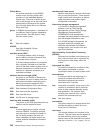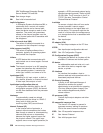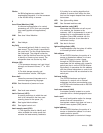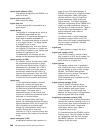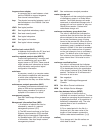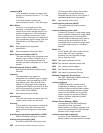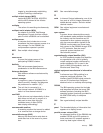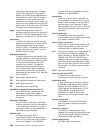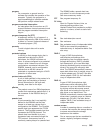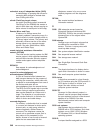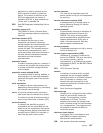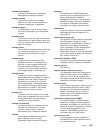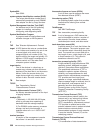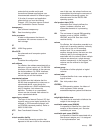associating multiple devices of a single
control-unit image with a single logical
device. Up to eight device addresses can
be assigned to a PAV. The PAV function
enables two or more concurrent write
operations to the same logical volume, as
long as the write operations are not to the
same extents. See also extent, I/O Priority
Queueing, and multiple allegiance.
parity A data checking scheme used in a
computer system to ensure the integrity of
the data. The RAID implementation uses
parity to re-create data if a disk drive fails.
path group
In zSeries architecture, a set of channel
paths that are defined to a control unit as
being associated with a single logical
partition (LPAR). The channel paths are in
a group state and are online to the host.
See also logical partition.
path group identifier
In zSeries architecture, the identifier that
uniquely identifies a given logical partition
(LPAR). The path group identifier is used
in communication between the LPAR
program and a device. The identifier
associates the path group with one or
more channel paths, thereby defining
these paths to the control unit as being
associated with the same LPAR. See also
logical partition.
PAV See parallel access volume.
PCI See peripheral component interconnect.
PDU See protocol data unit.
PE See IBM product engineering.
peripheral component interconnect (PCI)
An architecture for a system bus and
associated protocols that supports
attachments of adapter cards to a system
backplane.
persistent FlashCopy
A state where a FlashCopy relationship
remains indefinitely until the user deletes
it. The relationship between the source
and target volumes is maintained after a
background copy completes.
physical path
A single path through the I/O
interconnection fabric that attaches two
units. For Copy Services, this is the path
from a host adapter on one DS8000
(through cabling and switches) to a host
adapter on anotherDS8000.
pinned data
Data that is held in cache until either an
error condition is corrected and it can be
moved to disk storage or until the data is
discarded by a host command. Pinned
data conditions can only occur on an ESS
Model 800 during fast-write or dual-copy
functions.
point-in-time copy
A FlashCopy option that creates an
instantaneous view of original source data
at a specific moment in time.
point-to-point connection
A fibre-channel topology that enables the
direct interconnection of ports. See also
arbitrated loop and switched fabric.
port A physical connection on a host adapter to
the cable that connects the DS8000 to
hosts, switches, or another DS8000. The
DS8000 uses SCSI and ESCON host
adapters that have two ports per adapter,
and fibre-channel host adapters that have
one port. See also ESCON, fibre channel,
host adapter, and small computer system
interface.
POST See power-on self test.
power-on self test (POST)
A diagnostic test that servers or
computers run when they are turned on.
predictable write
A write operation that can cache without
knowledge of the existing format on the
medium. All write operations on FBA
DASD devices are predictable. On CKD
DASD devices, a write operation is
predictable if it does a format write
operation for the first data record on the
track.
primary control unit
The DS8000 to which a Remote Mirror
and Copy primary device is physically
attached.
processor complex
A partition of a storage server that is
capable of performing all defined functions
of the storage server. Multiple processor
complexes provide redundancy.
product engineering
See IBM product engineering.
344 IBM TotalStorage DS8000: Messages Reference



